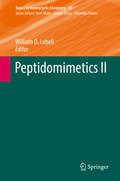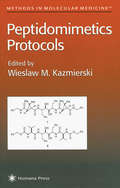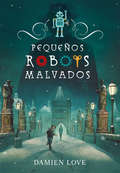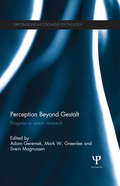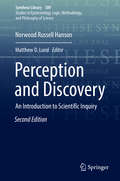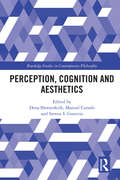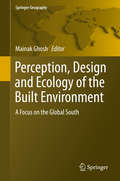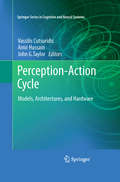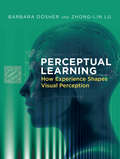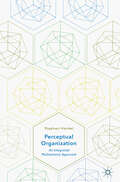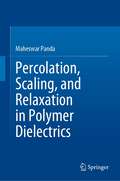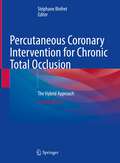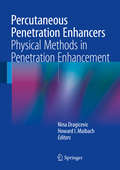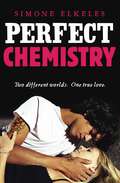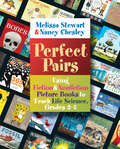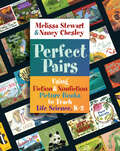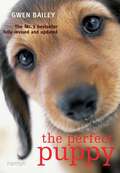- Table View
- List View
Peptidomimetics II
by William LubellThe series Topics in Heterocyclic Chemistry presents critical reviews on present and future trends in the research of heterocyclic compounds. Overall the scope is to cover topics dealing with all areas within heterocyclic chemistry, both experimental and theoretical, of interest to the general heterocyclic chemistry community. The series consists of topic related volumes edited by renowned editors with contributions of experts in the field. All chapters from Topics in Heterocyclic Chemistry are published Online First with an individual DOI. In references, Topics in Heterocyclic Chemistry is abbreviated as Top Heterocycl Chem and cited as a journal.
Peptidomimetics Protocols
by Wieslaw M. KazmierskiA state-of-the-art collection of detailed synthetic procedures that lead to a variety of scaffolds, turn mimetics, peptide-bound replacements, and enzyme inhibitors. Topics range from unusual syntheses of amino acids to the use of a variety of linear and heterocyclic scaffolds in place of the peptide backbone. Important chemical procedures and methods include the transient protection of charged peptides as neutral prodrugs for improved blood-brain penetration and the replacement of peptide bonds with heterocyclic rings, olefins and fluoroolefins, and ketomethylenes. Synthetic protocols towards the transition-state mimics and reactive "warheads," applicable in enzyme inhibitors, are also disclosed.
Peptidomimetics in Organic and Medicinal Chemistry
by Andrea Trabocchi Antonio GuarnaA peptidomimetic is a small protein-like chain designed to mimic a peptide with adjusted molecular properties such as enhanced stability or biological activity. It is a very powerful approach for the generation of small-molecule-based drugs as enzyme inhibitors or receptor ligands.Peptidomimetics in Organic and Medicinal Chemistry outlines the concepts and synthetic strategies underlying the building of bioactive compounds of a peptidomimetic nature. Topics covered include the chemistry of unnatural amino acids, peptide- and scaffold-based peptidomimetics, amino acid-side chain isosteres, backbone isosteres, dipeptide isosteres, beta-turn peptidomimetics, proline-mimetics as turn inducers, cyclic scaffolds, amino acid surrogates, and scaffolds for combinatorial chemistry of peptidomimetics. Case studies in the hit-to-lead process, such as the development of integrin ligands and thrombin inhibitors, illustrate the successful application of peptidomimetics in drug discovery.
Pequeños robots malvados
by Damien LoveMagia, robots y peligro... ¿qué puede salir mal? Un día de invierno, Alex recibe un misterioso regalo de su abuelo: un pequeño robot con una nota que dice "este es especial". Extraños sucesos comienzan a tener lugar, y Alex sospecha que su nuevo robot, más que especial, puede ser... ¿mortal? Damien Love vive en la ciudad de Glasgow, donde probablemente llueva mientras lees estas palabras. Ha trabajado como periodista durante muchos años, escribiendo sobre películas, música, televisión y otras cosas para una variedad de publicaciones, entre las cuales destacan The Sunday Herald, The Guardian y The Scotsman. Tiene la capacidad de hablar con los gatos, pero no hay evidencia de que lo entiendan. Pequeños robots malvados es su primera novela, un fascinante despliegue de imaginación y acción que te tendrá pegado a sus páginas.
Perception Beyond Gestalt: Progress in vision research (Explorations in Cognitive Psychology)
by Adam Geremek Mark W. Greenlee Svein MagnussenHow does the brain piece together the information required to achieve object recognition, figure-ground segmentation, object completion in cases of partial occlusion and related perceptual phenomena? This book focuses on principles of Gestalt psychology and the key issues which surround them, providing an up-to-date survey of the most interesting and highly debated topics in visual neuroscience, perception and object recognition. The volume is divided into three main parts: Gestalt and perceptual organisation, attention aftereffects and illusions, and color vision and art perception. Themes covered in the book include: - a historical review of Gestalt theory and its relevance in modern-day neuroscience- the relationship between perceptive and receptive fields- a critical analysis of spatiotemporal unity of perception- the role of Gestalt principles in perceptual organization- self-organizing properties of the visual field- the role of attention and perceptual grouping in forming non-retinotopic representations- figural distortions following adaptation to spatial patterns- illusory changes of brightness in spatial patterns- the function of motion illusions as a tool to study Gestalt principles in vision- conflicting theories of color vision and the neural basis of it- the role of color in figure-ground segmentation- chromatic assimilation in visual art and perception- the phenomena of colored shadows.Including contributions from experts in the field, this book will provide an essential overview of current research and theory on visual perception and Gestalt. It will be key reading for researchers and academics in the field of visual perception and neuroscience.
Perception and Discovery: An Introduction to Scientific Inquiry (Synthese Library #389)
by Norwood Russell HansonMatthew D. LundNorwood Russell Hanson was one of the most important philosophers of science of the post-war period. Hanson brought Wittgensteinian ordinary language philosophy to bear on the concepts of science, and his treatments of observation, discovery, and the theory-ladenness of scientific facts remain central to the philosophy of science. Additionally, Hanson was one of philosophy’s great personalities, and his sense of humor and charm come through fully in the pages of Perception and Discovery.Perception and Discovery, originally published in 1969, is Hanson’s posthumous textbook in philosophy of science. The book focuses on the indispensable role philosophy plays in scientific thinking. Perception and Discovery features Hanson’s most complete and mature account of theory-laden observation, a discussion of conceptual and logical boundaries, and a detailed treatment of the epistemological features of scientific research and scientific reasoning. This book is of interest to scholars of philosophy of science, particularly those concerned with Hanson’s thought and the development of the discipline in the middle of the 20th century. However, even fifty years after Hanson’s early death, Perception and Discovery still has a great deal to offer all readers interested in science.
Perception, Cognition and Aesthetics (Routledge Studies in Contemporary Philosophy)
by Steven S. Gouveia Dena Shottenkirk Manuel CuradoThis volume addresses key questions related to how content in thought is derived from perceptual experience. It includes chapters that focus on single issues on perception and cognition, as well as others that relate these issues to an important social construct that involves both perceptual experience and cognitive activities: aesthetics. While the volume includes many diverse views, several prominent themes unite the individual essays: a challenge to the notion of the discreet, and non-temporal, unit of perception, a challenge to the traditional divide between perception and cognition, and a challenge to the traditional divide between unconscious and conscious intentionality. Additionally, the chapters discuss the content of perceptual experience, the value of traditional notions of content, disjunctivism, adverbialism, and phenomenal experience. The final section of essays dealing with perception and cognition in aesthetics features work in experimental aesthetics and unique perspectives from artists and gallerists working outside of philosophy. Perception, Cognition and Aesthetics is a timely volume that offers a range of unique perspectives on debates in philosophy of mind surrounding perception and cognition. It will also appeal to scholars working in aesthetics and art theory who are interested in the ways these debates influence our understanding of art.
Perception, Design and Ecology of the Built Environment: A Focus on the Global South (Springer Geography)
by Mainak GhoshThis edited volume is a compilation of the ‘built environment’ in response to many investigations, analyses and sometimes mere observations of the various dialogues and interactions of the built, in context to its ecology, perception and design. The chapters concentrate on various independent issues, integrated as a holistic approach, both in terms of theoretical perspectives and practical approaches, predominantly focusing on the Global South. The book builds fabric knitting into the generic understanding of environment, perception and design encompassing ‘different’ attitudes and inspirations. This book is an important reference to topics concerning urbanism, urban developments and physical growth, and highlights new methodologies and practices. The book presumes an understanding unearthed from various dimensions and again woven back to a common theme, which emerges as the reader reads through.Various international experts of the respective fields working on the Global South contributed their latest research and insights to the different parts of the book. This trans-disciplinary volume appeals to scientists, students and professionals in the fields of architecture, geography, planning, environmental sciences and many more.
Perception-Action Cycle
by Amir Hussain Vassilis Cutsuridis John G. TaylorThe perception-action cycle is the circular flow of information that takes place between the organism and its environment in the course of a sensory-guided sequence of behaviour towards a goal. Each action causes changes in the environment that are analyzed bottom-up through the perceptual hierarchy and lead to the processing of further action, top-down through the executive hierarchy, toward motor effectors. These actions cause new changes that are analyzed and lead to new action, and so the cycle continues. The Perception-action cycle: Models, architectures and hardware book provides focused and easily accessible reviews of various aspects of the perception-action cycle. It is an unparalleled resource of information that will be an invaluable companion to anyone in constructing and developing models, algorithms and hardware implementations of autonomous machines empowered with cognitive capabilities. The book is divided into three main parts. In the first part, leading computational neuroscientists present brain-inspired models of perception, attention, cognitive control, decision making, conflict resolution and monitoring, knowledge representation and reasoning, learning and memory, planning and action, and consciousness grounded on experimental data. In the second part, architectures, algorithms, and systems with cognitive capabilities and minimal guidance from the brain, are discussed. These architectures, algorithms, and systems are inspired from the areas of cognitive science, computer vision, robotics, information theory, machine learning, computer agents and artificial intelligence. In the third part, the analysis, design and implementation of hardware systems with robust cognitive abilities from the areas of mechatronics, sensing technology, sensor fusion, smart sensor networks, control rules, controllability, stability, model/knowledge representation, and reasoning are discussed.
Perception: How Our Bodies Shape Our Minds
by Dennis Proffitt Drake BaerA groundbreaking popular psychology book that explores the deep connection between our body and our brain.Over decades of study, University of Virginia psychologist Dennis Proffitt has shown that we are each living our own personal version of Gulliver’s Travels, where the size and shape of the things we see are scaled to the size of our bodies, and our ability to interact with them. Stairs look less steep as dieters lose weight, baseballs grow bigger the better players hit, hills look less daunting if you’re standing next to a close friend, and learning happens faster when you can talk with your hands.Written with journalist Drake Baer, Perception marries academic rigor with mainstream accessibility. The research presented and the personalities profiled will show what it means to not only have, but be, your unique human body. The positive ramifications of viewing ourselves from this embodied perspective include greater athletic, academic, and professional achievement, more nourishing relationships, and greater personal well-being. The better we can understand what our bodies are—what they excel at, what they need, what they must avoid—the better we can live our lives.
Perceptual Intelligence: The Brain's Secret to Seeing Past Illusion, Misperception, and Self-Deception
by Montel Williams Brian Boxer WachlerThe Secret Behind Our Perceptions Finally Revealed!Why do we gravitate to products endorsed by celebrities? Why does time seem to go by faster as we get older? Why are some athletes perpetual winners and others losers? Exploring the brain’s ability to interpret and make sense of the world, Dr. Brian Boxer Wachler describes how your perception can be reality or fantasy and how to separate the two, which is the basis of improving your Perceptual Intelligence (PI). With concrete examples and case studies, Dr. Brian (as he’s known to his patients) explains why our senses do not always match reality and how we can influence the world around us through perceptions, inward and outward. By fine-tuning your PI, you can better understand what’s really going on and make more insightful decisions in your life.
Perceptual Learning: How Experience Shapes Visual Perception
by Zhong-Lin Lu Barbara DosherA comprehensive and integrated introduction to the phenomena and theories of perceptual learning, focusing on the visual domain.Practice or training in perceptual tasks improves the quality of perceptual performance, often by a substantial amount. This improvement is called perceptual learning (in contrast to learning in the cognitive or motor domains), and it has become an active area of research of both theoretical and practical significance. This book offers a comprehensive introduction to the phenomena and theories of perceptual learning, focusing on the visual domain.
Perceptual Organization: An Integrated Multisensory Approach
by Stephen HandelThis textbook goes beyond introductory sensory perception by incorporating supplementary electronic materials to demonstrate the parallels between both hearing and seeing. Each chapter intermixes seeing and hearing processes so that students can easily understand that perceptual organization is the same across different kinds of sensations and modalities. Figures illustrating visual organization are paired with sound files demonstrating the analogous auditory organization. While most books on sensation and/or perception treat the senses individually there is growing awareness of just how important multisensory integration is to understanding the connection between sensory perception and cognition.
Perchlorate: Environmental Problems and Solutions
by Kathleen Sellers Katherine Weeks William R. Alsop Stephen R. Clough Marilyn Hoyt Barbara Pugh Joseph RobbThe development of analytical methods for identifying widespread perchlorate contamination brought about an explosion of research into the environmental problems and their potential solutions along with a corresponding increase in the availability of information. Unlike reference works that focus on only a few aspects of this contaminant, Perchlora
Percolation Theory Using Python (Lecture Notes in Physics #1029)
by Anders Malthe-SørenssenThis course-based open access textbook delves into percolation theory, examining the physical properties of random media—materials characterized by varying sizes of holes and pores. The focus is on both the mathematical foundations and the computational and statistical methods used in this field. Designed as a practical introduction, the book places particular emphasis on providing a comprehensive set of computational tools necessary for studying percolation theory. Readers will learn how to generate, analyze, and comprehend data and models, with detailed theoretical discussions complemented by accessible computer codes. The book's structure ensures a complete exploration of worked examples, encompassing theory, modeling, implementation, analysis, and the resulting connections between theory and analysis. Beginning with a simplified model system—a model porous medium—whose mathematical theory is well-established, the book subsequently applies the same framework to realistic random systems. Key topics covered include one- and infinite-dimensional percolation, clusters, scaling theory, diffusion in disordered media, and dynamic processes. Aimed at graduate students and researchers, this textbook serves as a foundational resource for understanding essential concepts in modern statistical physics, such as disorder, scaling, and fractal geometry.
Percolation, Scaling, and Relaxation in Polymer Dielectrics
by Maheswar PandaThis book provides a foundational understanding of polymer dielectrics based on percolative composites. It covers the microstructure and physical properties, such as dielectric, electrical, magnetic, and rheological properties, of polymer composites, as well as how these properties can be explained using various theoretical models and spectroscopy techniques, such as dielectric spectroscopy, impedance spectroscopy, and conductivity spectroscopy. The book also discusses non-percolative polymer composites and the suitability of polymer dielectrics for electrical energy storage in various devices. It is intended for graduate students and professionals in fields such as condensed matter physics, applied physics, statistical physics, materials science, polymer science and technology, chemistry, and engineering. It will be particularly useful for physicists, materials scientists, polymer scientists, chemists, engineers, and others interested in the physics and applications of percolative composites based on polymer matrix.
Percutaneous Coronary Intervention for Chronic Total Occlusion: The Hybrid Approach
by Stéphane RinfretThe second edition of this essential text provides readers with a detailed guide to performing various percutaneous coronary intervention (PCI) techniques for treating coronary chronic total occlusion (CTO). PCI continues to be an effective procedure to help patients with this pathology, with high success and low complications rates. Chapters feature a step-by-step approach to relevant techniques and describe their potential pitfalls, enabling the reader to develop a thorough understanding of how to perform those procedures successfully. Details of the latest methods for angiography analysis and the management of ostial CTOs, plus heavily revised chapters on topics such as contemporary device-based antegrade dissection and the retrograde approach through septal and non-septal collateral channels ensure that this Work remains the most up-to-date reference on the subject. Percutaneous Intervention for Coronary Chronic Total Occlusion: The Hybrid Approach represents a vital reference to assist practicing and trainee interventional cardiologist in learning these techniques. Various examples are provided, with a vast selection of still images and angiographic video loops to enable the reader become confident in applying these methodologies into their day-to day clinical practice.
Percutaneous Penetration Enhancers Physical Methods in Penetration Enhancement
by Howard I. Maibach Nina DragicevicPercutaneous Penetration Enhancers in a mini-series format comprising five volumes, represents the most comprehensive reference on enhancement methods - both well established and recently introduced - in the field of dermal/transdermal drug delivery. In detail the broad range of both chemical and physical methods used to enhance the skin delivery of drugs is described. All aspects of drug delivery and measurement of penetration are covered, and the latest findings are provided on skin structure and function, mathematics in skin permeation, and modern analytical techniques adapted to assess and measure penetration. In offering a detailed description of the methods currently in use for penetration enhancement, this book will be of value for researchers, pharmaceutical scientists, practitioners, and also students.
Perfect Chemistry (A Perfect Chemistry Triology #1)
by Simone ElkelesFrom the New York Times bestselling author Simone Elkeles comes an epic love story like no other . . . First in the gripping PERFECT CHEMISTRY series, this is the next addictive read for fans of Anna Todd's AFTER series, and Caroline Kepnes's YOU.When Brittany Ellis walks into chemistry class on the first day of senior year, she has no clue that her carefully created 'perfect' life is about to unravel before her eyes. Forced to be lab partners with Alex Fuentes, a gang member from the other side of town, Brittany finds herself having to protect everything she's worked so hard for – her flawless reputation, her relationship with her boyfriend and, most importantly, the secret that her home life is anything but perfect.Alex is a bad boy and he knows it. So when he makes a bet with his friends to lure Brittany into his life, he thinks nothing of it. But the closer Alex and Brittany get to each other the more they realise that sometimes appearances can be deceptive and that you have to look beneath the surface to discover the truth.
Perfect Image: The Clone Series (The Clone Series #3)
by Trish MoranThe final installment of Trish Moran's acclaimed young adult series exploring humanity, technology, and the problems of growing up in a dystopian future. Perfect for fans of The Giver and the Divergent trilogy.The Compound Labs, the original group of clones freed from the notorious medical centre, are continuing to live successfully alongside the normal humans in society.They are uneasy to realize that the militant group of clones, the Radicals, are gaining more and more followers from the Labs and their Hybrid children.The Radicals, sponsored by an anonymous billionaire, have a vision of a future society where every member is given a designated role according to their abilities. They have plans to rule this new way of life with a specially created perfect clone and his equally talented team, showing little regard for those they consider inferior mentally and physically.Have they created a team of unfeeling, super-intelligent people who will stop at nothing to achieve their aims?Are the Compound Labs strong enough to defeat them in their crusade? Can a young Hybrid girl use the power of love and compassion to challenge the course they have set themselves?
Perfect Image: The Clone Series (The\clone Ser. #3)
by Trish MoranThe final installment of Trish Moran's acclaimed young adult series exploring humanity, technology, and the problems of growing up in a dystopian future. Perfect for fans of The Giver and the Divergent trilogy.The Compound Labs, the original group of clones freed from the notorious medical centre, are continuing to live successfully alongside the normal humans in society.They are uneasy to realize that the militant group of clones, the Radicals, are gaining more and more followers from the Labs and their Hybrid children.The Radicals, sponsored by an anonymous billionaire, have a vision of a future society where every member is given a designated role according to their abilities. They have plans to rule this new way of life with a specially created perfect clone and his equally talented team, showing little regard for those they consider inferior mentally and physically.Have they created a team of unfeeling, super-intelligent people who will stop at nothing to achieve their aims?Are the Compound Labs strong enough to defeat them in their crusade? Can a young Hybrid girl use the power of love and compassion to challenge the course they have set themselves?
Perfect Pairs, 3-5: Using Fiction & Nonfiction Picture Books to Teach Life Science, Grades 3-5
by Melissa Stewart Nancy ChesleyHands-on lessons can be fun and compelling, but when it comes to life science, they aren't always possible, practical, effective, or safe. Children can't follow wolves as they hunt elk, visit a prehistoric swamp, or shrink down to the size of a molecule and observe photosynthesis firsthand. But they can explore a whole world of animals, plants, and ecosystems through the pages of beautifully illustrated, science-themed picture books. Perfect Pairs , which marries fiction and nonfiction picture books focused on life science, helps educators think about and teach life science in a whole new way. Each of the twenty lessons in this book is built around a pair of books that introduces a critical life science concept and guides students through an inquiry-based investigative process to explore that idea-;from life cycles and animal-environment interactions to the inheritance of traits and the critical role of energy in our world. Each lesson starts with a Wonder Statement and comprises three stages. Engaging Students features a hands-on activity that captures student interest, uncovers current thinking, and generates vocabulary. The heart of the investigative process, Exploring with Students, spotlights the paired books as the teacher reads aloud and helps students find and organize information into data tables. Encouraging Students to Draw Conclusions shows students how to review and analyze the information they have collected. Bringing high-quality science-themed picture books into the classroom engages a broad range of students, addresses the Performance Expectations outlined in the Next Generation Science Standards, and supports the goals of the Common Core State Standards for English Language Arts. Even if you are science shy, Perfect Pairs can help you become a more confident teacher whose classroom buzzes with curious students eager to explore their natural world.
Perfect Pairs, K-2: Using Fiction & Nonfiction Picture Books to Teach Life Science, K-2
by Melissa Stewart Nancy ChesleyHands-on lessons can be fun and compelling, but when it comes to life science, they aren't always possible, practical, effective, or safe. Children can't follow a lion as it stalks a gazelle, visit the exotic kapok tree in a rain forest, or swim alongside the underwater life in a pond. But they can explore a whole world of animals, plants, and ecosystems through the pages of beautifully illustrated, science-themed picture books. Perfect Pairs , which marries fiction and nonfiction picture books focused on life science, helps educators think about and teach life science in a whole new way. Each of the twenty-two lessons in this book is built around a pair of books that introduces a critical life science concept and guides students through an inquiry-based investigative process to explore that idea-;from animal/environment interactions to the role of structure in plant and animal survival, from inheritance of traits to variation of species. Each lesson starts with a Wonder Statement- and comprises three stages. Engaging Students- features a hands-on activity that captures student interest, uncovers current thinking, and generates vocabulary. The heart of the investigative process, Exploring with Students,- spotlights the paired books as the teacher reads aloud and helps students find and organize information into data tables. Encouraging Students to Draw Conclusions- shows students how to review and analyze the information they have collected. Bringing high-quality science-themed picture books into the classroom engages a broad range of students, addresses the Performance Expectations outlined in the Next Generation Science Standards, and supports the goals of the Common Core State Standards for English Language Arts. Even if you are science shy,Perfect Pairs can help you become a more confident teacher whose classroom buzzes with curious students eager to explore their natural world.
Perfect Puppy: The No.1 bestseller fully revised and updated
by Gwen BaileyNEW EDITION OUT AUGUST 2024 Gwen Bailey's puppy care guide has helped hundreds of thousands of owners throughout the world raise a problem-free dog. Now, updated with the latest findings in canine behaviour and a completely new user-friendly design, this revised edition will teach you how to raise a problem-free dog. From housetraining to playing games, it will show you how to teach your dog good manners and build his confidence with the world around him. There are step-by-step training and socialisation plans as well as a guide to understanding and preventing biting, chewing and other problems.If you want your puppy to develop into a happy, well-behaved and friendly adult dog, you cannot afford to be without this book.
Perfect Puppy: The No.1 bestseller fully revised and updated
by Gwen BaileyNEW EDITION OUT AUGUST 2024 Gwen Bailey's puppy care guide has helped hundreds of thousands of owners throughout the world raise a problem-free dog. Now, updated with the latest findings in canine behaviour and a completely new user-friendly design, this revised edition will teach you how to raise a problem-free dog. From housetraining to playing games, it will show you how to teach your dog good manners and build his confidence with the world around him. There are step-by-step training and socialisation plans as well as a guide to understanding and preventing biting, chewing and other problems.If you want your puppy to develop into a happy, well-behaved and friendly adult dog, you cannot afford to be without this book.
